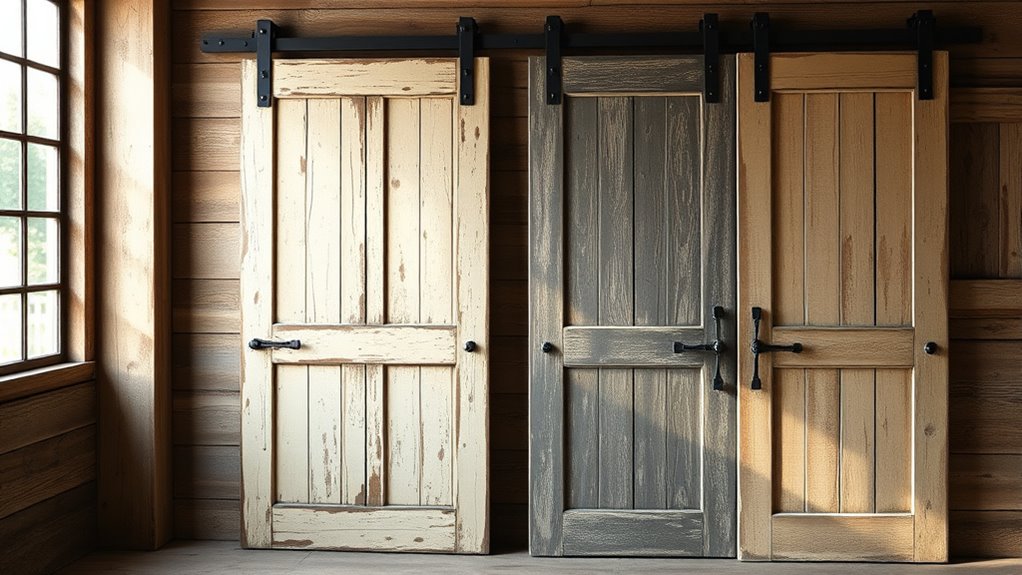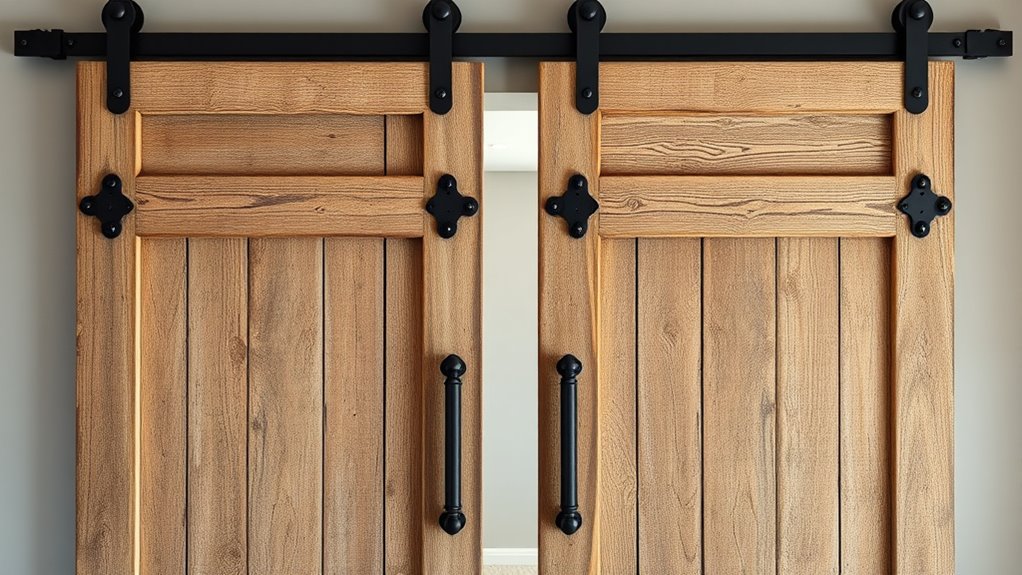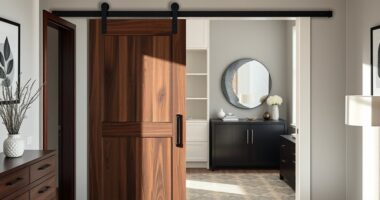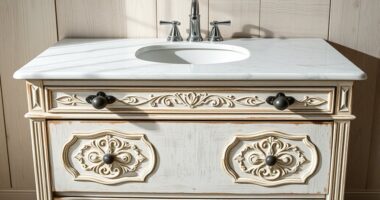To give new life to antique doors as sliding barn doors, start by inspecting the door thoroughly for damage or stability issues. Carefully repair cracks, sand surfaces, and remove old paint or stains. Choose durable hardware that matches your style, like wrought iron or brass, and install it securely to support the door’s weight. By preserving its character and blending modern hardware, you can transform a timeless piece into a functional, eye-catching feature—if you continue exploring, you’ll discover how to make it truly stand out.
Key Takeaways
- Assess and repair structural damage to ensure the antique door is stable for sliding installation.
- Carefully clean, sand, and restore the surface while preserving original decorative details.
- Select appropriate heavy-duty hardware that complements the door’s style and supports its weight.
- Adapt traditional hardware for modern sliding mechanisms, maintaining the door’s historic charm.
- Securely install hardware, test operation, and finish with protective coatings for durability and aesthetic appeal.

Have you ever considered transforming antique doors into stylish sliding barn doors? If so, you’re about to discover how this creative project can bring a unique charm and character to your space. The key to a successful transformation lies in understanding the right restoration techniques and choosing the appropriate hardware. Restoring an antique door isn’t just about making it look good; it’s about preserving its history while adapting it to modern use.
Transform antique doors into charming sliding barn doors by restoring their history and selecting perfect hardware.
Start by examining the door carefully. Look for any damage, such as cracks, warping, or missing pieces. Using proper restoration techniques, you can address these issues effectively. For instance, if the wood is cracked, you might need to fill the gaps with wood filler or use wood glue to stabilize loose parts. Sanding is an essential step—it smooths rough surfaces and prepares the door for finishing. When removing old paint or stains, opt for gentle methods like chemical strippers or sanding rather than harsh chemicals that could damage the wood’s integrity. Restoring antique doors also involves paying attention to the details—cleaning decorative hardware, repairing or replacing broken glass panels, and making sure the overall structure is solid.
Once the door is restored to a sturdy, appealing state, the next step involves hardware selection. This choice is vital because it not only supports the door’s functionality but also enhances its aesthetic appeal. When selecting hardware, consider the style of your space—rustic, vintage, or modern—and pick pieces that complement the door’s character. Heavy-duty, track-based hardware is ideal for sliding barn doors, providing durability and smooth operation. Look for hardware made from materials like wrought iron, brass, or matte black metal to match various interior styles. Make sure the hardware you choose can support the weight of the door, especially if it’s an antique with dense wood. Proper mounting is essential; follow the manufacturer’s instructions meticulously to guarantee safety and longevity. Additionally, understanding the self-watering plant pots system can inspire you to incorporate functional elements into your home decor, blending style with practicality.
Incorporating these restoration techniques and thoughtful hardware selection will not only give your antique door a new purpose but also preserve its timeless beauty. The process requires patience and attention to detail, but the results will be well worth it. You’ll end up with a one-of-a-kind sliding barn door that adds character and functionality to your home. Whether you’re converting a historic piece into a functional element or simply repurposing an old door for aesthetic appeal, focusing on these key aspects guarantees a successful transformation. With a little effort, you can breathe new life into an antique door and turn it into a stunning feature that tells a story while serving a practical purpose.
Frequently Asked Questions
How Do I Securely Hang an Antique Door as a Sliding Barn Door?
To securely hang an antique door as a sliding barn door, start with sturdy hardware installation designed for heavy weight capacity. Use heavy-duty rails and rollers, ensuring they are properly anchored into the wall studs. Double-check that the hardware matches the door’s weight, and evenly distribute the load to prevent sagging. Regularly inspect and tighten the hardware to keep the door secure and functioning smoothly.
What Are the Best Finishes to Protect Antique Wood Doors?
You should choose finishes like vintage paint or protective coatings to guarantee your antique wood door. Vintage paint adds a charming, authentic look while providing a layer of protection. Protective coatings, such as polyurethane or sealants, safeguard against moisture, scratches, and wear. Applying these finishes assures your door stays beautiful and durable over time, maintaining its vintage charm while offering long-lasting protection.
Can I Convert Any Antique Door Into a Sliding Barn Door?
Turning your antique door into a sliding barn door is like giving it a second chance at life. Not every door is perfect for this; you need to evaluate door restoration, structure, and weight. While many antique doors can be transformed, some may require reinforcement or modifications for antique preservation. Consult a professional to assess if your door can be safely and beautifully converted into a sliding barn door.
How Do I Prevent Warping or Damage Over Time?
To prevent warping or damage over time, you should control humidity levels in your space and perform regular maintenance. Keep humidity steady between 40-60% to minimize wood expansion or contraction. Regularly inspect the door for any signs of wear, and treat the wood with protective finishes or sealants. Proper humidity control and upkeep guarantee your antique sliding barn door remains beautiful and functional for years.
Are There Size Limitations for Sliding Antique Doors?
You can generally adapt antique doors for sliding barn use, but size limitations depend on your hardware compatibility and aesthetic goals. Larger doors need sturdy tracks and rollers to support weight and guarantee smooth operation. Consider how the door’s size complements your space and design style. Always check the hardware specifications and ensure they can handle the door’s dimensions, so your installation remains functional and visually appealing over time.
Conclusion
Revitalizing antique doors as sliding barn doors not only adds charm but also reduces waste—did you know that up to 85% of furniture can be repurposed instead of discarded? By giving these vintage pieces a new purpose, you’re preserving history while enhancing your space. Plus, with the right craftsmanship, your antique door can become a stunning, functional focal point. So, why not breathe new life into a piece of the past and create something truly unique?









